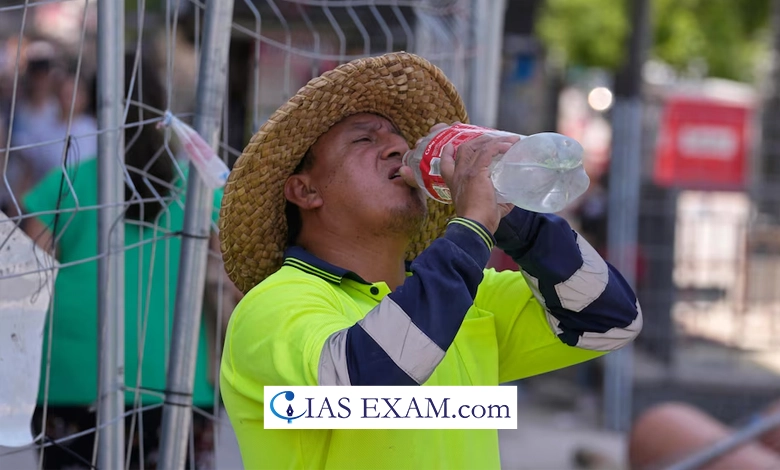Global Workforce Vulnerability to Excessive Heat
Syllabus: Health [GS Paper-2]

Context
The International Labor Organization (ILO) recently released a report titled “Ensuring safety and health at work in a changing climate,” which highlights the growing threat of excessive heat to workers worldwide.
Key findings from the report include
- The report indicates a directive to guidelines union experts that worldwide there are 2.4 billion of the workforce exposed to excessive heat, and in the long run this can lead to a number of health disorders, including cancer, cardiovascular and respiratory diseases, as well as mental problems.
- The most deadly risk for the workers trading in the streets is the air pollution that every year leads to approximately 860,000 work-related deaths among outdoor workers.
- The ailments including about 18,970 such professional deaths through excessive heat are found each year.
- Approximately 18,960 deaths per year are associated with non–melanoma-UV-radiation disease.
- In the report, a call was made for the immediate push of action steps to protect workers, in particular those in regions such as India, where high temperatures can have devastating effects on the health and production of outdoor workers.
- It thus refers to the development of innovative solutions based on social dialogue for the implementation of safety and health at work for all groups of employees. This refers to people working in the most risky conditions.
Excessive Heat
- Over 2.4 billion workers suffer from exposure to the heat beyond the acceptable level, which might induce heat stress, heat exhaustion and heat stroke.
- 1.The number of workers who are directly exposed to the sun is about 6 billion people and they are in danger of developing skin cancer, cataracts, and other eye troubles because it is the time when the radiation of solar ultraviolet (UV) rays is the highest.
- 1.65 million orders workforce which becomes a menace to health due to the air pollution that can get a person into breathing problems and other illnesses.
Health Impacts
- 22.85 million occupational injuries, 18,970 deaths, and 2.09 million disability-adjusted life years (DALYs) are attributable to excessive heat alone.
- 26.2 million people are living with chronic kidney disease due to exposure to excessive heat at work.
- Over 300,000 deaths are attributed to pesticide poisoning annually.
Vulnerable Groups
- Workers who are outside performing industrial jobs of high physical exhaustion, including construction, agriculture and road transportation, have a very high possibility of absorbing temperatures.
- The poor indoor workers in construction and manufacturing markets where ventilation is not very good are another risk set.
- If females are more exposed to work by nature of what they do, like the case with subsistence farming, then they may likely be at higher risk.
- Men labourers will most probably do dirty physical work in buildings and agricultural sectors that mostly are exposed to excessive heat and, therefore, are highly at risk of most negative effects of climate change.
Recommendations
- Government, employers and associates unreservedly ought to be involved in making and execution as well as programs to protect employees from excessive heat and other climate related dangers.
- OSH rules and regulations should have to be updated, as these ensue to the mounting health concerns with climate change.
- Workers must get sufficient education, constantly wear personal protective equipment (PPE), and use accessible healthcare services to diminish the consequences of too high heat and other weather factors.
- Collective bargaining and social dialog should be supported to uphold respect for employees rights and interests while confronting global climate challenges.
Conclusion
The ILO report highlights the urgent need for governments, employers, and workers to take action to protect workers from excessive heat and other climate-related hazards. The report’s findings and recommendations provide a valuable resource for policymakers, employers, and workers to develop and implement effective strategies to mitigate the risks associated with climate change and ensure a safe and healthy working environment for all.
Source: DTE
Also Read: ILO Study Report on ‘Forced Labour’
UPSC Mains Practice Question
Q. Discuss the findings of the International Labour Organization (ILO) report indicating that over 2.4 billion of workers globally are exposed to excessive heat. Analyse the implications of this phenomenon on occupational health, productivity, and socio-economic development.





.png)



